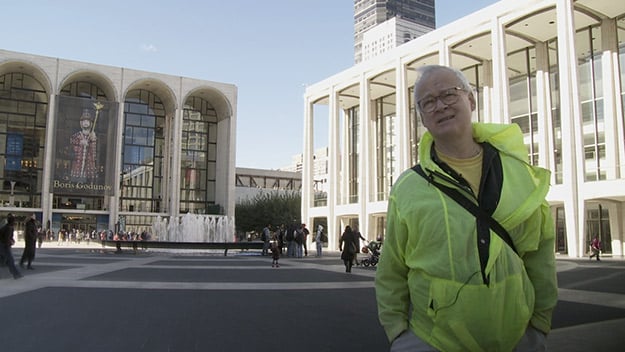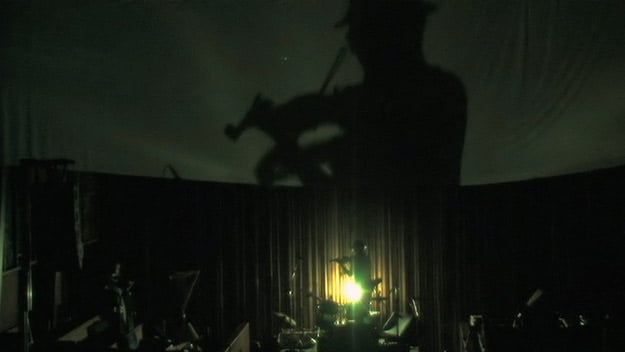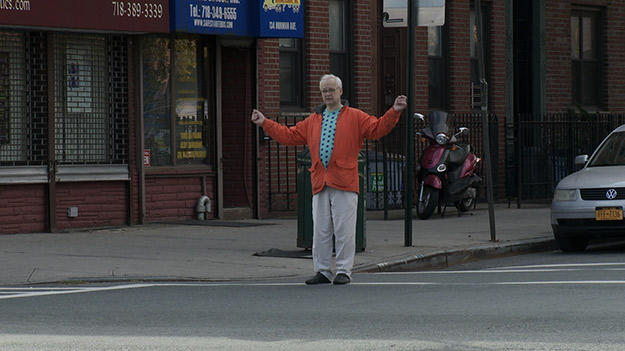Film of the Week: Tony Conrad: Completely in the Present

The late Tony Conrad was one of those people that British writer Iain Sinclair sometimes refers to as the “reforgotten”—those cultural figures who slide in and out of some dim limelight, usually staying in the margins, sometimes revered by a small but impassioned coterie, but often destined ultimately to be neglected or forgotten again, their perpetual obscurity or semi-obscurity a mark of their authenticity and enduring energy. Conrad would be rediscovered from time to time, even getting some mainstream press attention before his death last April aged 76. Now his life, in all its wayward and sometimes comical complexity, is captured in Tyler Hubby’s documentary Tony Conrad: Completely in the Present.
The title comes from a statement of the artist’s—“History is like music: completely in the present”—and one of the virtues of Hubby’s film, and of Conrad’s own discussion of his career, is that his history never really seems to belong to the past. That is, Conrad doesn’t reminisce like those artists whose discourse essentially fetishizes, classifies, and files away their own glory years: his witty and often amused account brings his past alive in the now, all the more so because, filmed over different points in the recent past, he’s always still up to something new.
Accounts of Conrad’s career often run the risk of presenting him as some kind of Zelig of American avant-gardism, as someone who was always there on the sidelines or in the background when other people were doing great things. Conrad’s may be one of the less celebrated names in the roster of those mentioned or appearing here—among them, La Monte Young, Lou Reed, John Cale, Jack Smith, Hollis Frampton, Tony Oursler, the German band Faust. But Hubby’s film argues that he belonged as much in the forefront as anyone else, and that in one particular instance, he was robbed of his central position in modern music history.
Conrad was an artist, a musician, a filmmaker, a teacher, a Harvard-educated mathematician, and an inveterate wearer of jaunty hats, as well as—unofficially, the film shows us—a trenchantly self-deprecating comedian. Students of American experimental cinema will know him as the maker of the 1966 piece The Flicker, a meticulously calibrated succession of black and white frames which on its premiere caused the projectionist to incur a migraine. Remembering it with typically quizzical humor, Conrad recalls that a third of the audience walked out, a third professed indifference, and a third “had weird things to report…” With his late wife, Beverly Conrad—formerly Beverly Grant, star of Jack Smith’s Normal Love—he went on to make Straight and Narrow (70). It was a similarly minimalist creation—“What could be simpler than black and white stripes?”—yet, accidentally or intentionally, possessed of an extraordinary Len Lye/Norman McLaren bounciness. “Screw abstract act,” Conrad remembers thinking, “I’m going to make abstract art funny, happy, energetic, joyful…”

Much of his visual or conceptual art fits this pattern: its conceptualism is perverse, often goofy, and concerned with redefining categories. Conrad has played knowingly on what it means to be a filmmaker, an activity which might involve simply processing film in some unlikely material fashion, or simulating cinema in different forms. Yellow Movies (1972-73) came from the idea of a making a film that would run for 50 years or so. In fact, these “movies” are patches of emulsion painted directly on walls in frames that suggest a cinema screen, which then react slowly to the elements over a long period: the whole thing seems to arise from an implicit pun to do with the meaning of “film,” i.e. either movie or membrane. Later, Conrad—in keeping with a phase in which he was staying home and doing most of his family’s housework—explored the pursuit of literally cooking film, pickling and frying it or using it like onion, and placing the results in storage jars (a slightly less unappetizing variant, perhaps, on Piero Manzoni’s notorious early ’60s Merda d’Artista, or canned artist’s shit).
Later works included experiments with public access TV, like 1990’s Homework Helpline—literally, helping children deal with their homework, “the most despised institution in the world, outside war.” And there was the long-running, unfinished Jail project, which involved building a scale-model replica prison and filling it with men dressed as women—participants including the artists Tony Oursler and the late Mike Kelley. Started in the early ’80s, the project was abandoned as money ran out, but Conrad kept paying the rent on the site for something like 30 years—an act that sounds like a conceptual piece in itself (Mixed media: continued financial investment in suspended project).
Alongside all this is the “other” Conrad, perhaps the more widely known one—not to say that his fields of activity are in any real way separate. Conrad is known in the music world as a violinist with a very particular style, his refusal of vibrato and his mastery of precise microtonal shifts leading musician-producer Jim O’Rourke to say that Conrad’s violin is as immediately recognizable as Miles Davis’s trumpet or Cecil Taylor’s piano. As a Harvard mathematics student, Conrad would come to New York in the early 60s and perform with La Monte Young, Marian Zazeela, John Cale, and others in what came to be known as the Theatre of Eternal Music, or the Dream Syndicate. The drone music they created was massively influential—not least because Cale later transplanted elements of it into the Velvet Underground—and, most importantly, it was communally created as music without a composer. La Monte Young had different ideas, however, and for decades refused to give other members of the group (or “sect,” as one commentator calls it) access to tapes of their performances. The Dream Syndicate music eventually appeared on CD in 2000, to Young’s fury, as Conrad’s contribution came to be fully recognized. In other words, it’s argued here—notably by Jeff Hunt, founder of the Table of the Elements label—Conrad had been written out of the history of American minimalist music, in which he should be recognized for being as significant a founding figure as Young, Glass, Reich, and Riley. His rediscovered 1964 recording Four Violins, for which he multi-tracked himself, is for Hunt “the smoking gun” of minimalist music history, and it still sounds startling—like the Metal Machine Music of catgut and rosin.

Conrad seems to taken his neglect fairly affably—although he’s seen picketing a Young appearance with a densely worded protest placard in hand. It seems, however, he was happy with his position in the margins, perhaps because he was so consistently active, while more recent musical work, including recordings with the likes of Steve Albini and a reunion with early-’70s collaborators Faust, brought him back to the attention of the rock/experimental crossover fringe.
Hubby’s documentary may not be formally as startling as its subject’s work, but it is informative and appears to be fairly comprehensive, although one regrets the non-mention of a 2003 work called Putin’s Gas Station, which you’d imagine may be gaining some fresh currency right now. Conrad is someone who, above all, seems to have had a lot of fun, and is visibly still having it in front of Hubby’s camera, notably when he’s seen standing in the street directing traffic, in both the cop and auteur senses (“Did I ask for a motorcycle? Bring on the box van”). At one point during a recent Conrad interview on a park bench, a woman wanders into frame, leans towards the camera, exposes her breasts and walks off. An unflappable Conrad doesn’t even seem to notice. Setup? Happenstance glitch in the filming process? Who knows? But it makes you laugh, and that surely qualifies it as a supremely Conradian moment.







